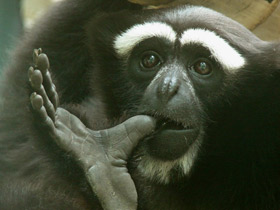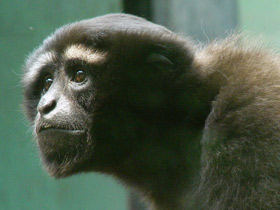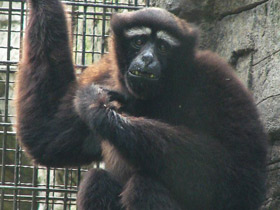The hoolock gibbons(genus Hoolock)
The hoolock gibbons are three primate species of genus Hoolock in the gibbon family, Hylobatidae, native to eastern Bangladesh, Northeast India, Myanmar, and Southwest China.
Description
Hoolocks are the second-largest of the gibbons, after the siamang. They reach a size of 60 to 90 cm and weigh 6 to 9 kg. The sexes are about the same size, but they differ considerably in coloration; males are black-colored with remarkable white brows, while females have a grey-brown fur, which is darker at the chest and neck. White rings around their eyes and mouths give their faces a mask-like appearance. The Oxford English Dictionary says that the name "hoolock" is from "a language of Assam."
Distribution
In northeast India, the hoolock is found south of Brahmaputra and the North Bank areas and east of the Dibang Rivers. Its range extends into seven states covering Arunachal Pradesh, Assam, Manipur, Meghalaya, Mizoram, Nagaland, and Tripura (The seven northeastern states of India). The species are protected in India in the Hollongapar Gibbon sanctuary, which support 125 Individuals of the species, as of 2023. In Bangladesh, the western hoolock gibbons were distributed across 35 forest fragments. The largest of these (Lawachara and Kaptai) supported 42 and 84 individuals respectively, but 17 of the fragments had less than ten individuals. For a better overview the forest fragments are grouped into 13 areas. All areas are located within Chittagong and Sylhet divisions, mostly near the eastern border of the country. In China, in historical times, the skywalker gibbon was recorded in nine counties in the west bank of the Salween River in westernmost Yunnan province. Based on more recent interview surveys conducted in October–November 2008 and field surveys conducted in Mar, Apr, and Aug 2009, the current Chinese population of hoolock gibbons was found to be restricted to three counties (Baoshan, Tengchong, and Yingjiang). The population size was estimated to be less than 200 individuals. In Myanmar, all three species of hoolock gibbon can be found in the forested areas west of Thanlwin river. Of all four distribution countries, Myanmar holds the key population of all three species.
Behaviour and diet
Like the other gibbons, they are diurnal and arboreal, brachiating through the trees with their long arms. They live together in monogamous pairs, which stake out a territory. Their calls serve to locate family members and ward off other gibbons from their territory. Their diet consists mainly of fruits, insects and leaves.
Breeding and lifecycle
Young hoolocks are born after a 7-month gestation, with milky white or buff-colored hair. After about 6 months, the hair of males darkens and turns black, while the females' hair remains buff-colored throughout their lives. After 8–9 years, they are fully mature and their fur reaches its final coloration. Their life expectancy in the wild is about 25 years.
Classification
The classification of this gibbon has changed several times in the past few years. Classically, all gibbons were classified in the genus Hylobates, with the exception of the siamang. After some studies, the genus was divided into three subgenera (including the siamang's Symphalangus), and then into four (recognizing Bunopithecus as the hoolock subgenus distinct from other gibbon subgenera). These four subgenera were elevated to full genus status. However, the type species for Bunopithecus is Bunopithecus sericus, an extinct gibbon or gibbon-like ape from Sichuan, China. Very recent investigations have shown that the hoolock gibbons are not closely related to B. sericus, so they have been placed in their own genus, Hoolock. In the process, the two subspecies of hoolock gibbons have been raised to species level. A new subspecies of the western hoolock gibbon has been described recently from northeastern India, which has been named the Mishmi Hills hoolock gibbon, H. hoolock mishmiensis. A further new species, H. tianxing, with an estimated population of about 200, was discovered in southwest China in 2017.
The species of hoolock are:
- Western hoolock gibbon, Hoolock hoolock;
- Eastern hoolock gibbon, Hoolock leuconedys;
- Skywalker hoolock gibbon, Hoolock tianxing.
The eastern hoolock gibbon (Hoolock leuconedys)
The eastern hoolock gibbon (Hoolock leuconedys) is a primate from the gibbon family, Hylobatidae. It is one of three species of hoolock gibbon. This species is found in east of the Chindwin River, such as the Mahamyaing Wildlife Sanctuary, and in south west Yunnan of China. Recent study published in April, 2021, in International Journal of Primatology confirmed that this species is not found in India as it was thought to be.
Taxonomy
Mootnick and Groves stated that hoolock gibbons do not belong in the genus Bunopithecus, and placed them in a new genus, Hoolock. This genus was argued to contain two distinct species which were previously thought to be subspecies: Hoolock hoolock and Hoolock leuconedys. The ranges of the two species are unclear and may overlap, and intermediates may occur.
Habitat area
Hoolock leuconedys is found in southern China and northeastern Myanmar, as well as in far eastern India. It lives in humid forests in the plains and in the mountains, at altitudes up to 2,700 metres above sea level, and in broad-leaved forests, staying predominantly in the upper levels. Water is avoided by Hoolock leuconedys.
Appearance and nutrition
Like all gibbons, Hoolock leuconedys is tailless. Male and female gibbons are black, while females vary in colour from yellowish white to light brown or grey. Males have white eyebrows and, unlike western Hoolock leuconedys, these eyebrows are not attached. The average height of the Hoolock leuconedys is 81.2 cm, the average weight of females is 6.1 kg and that of males is 6.9 kg. Life expectancy in captivity is up to 40 years.
Nutrition and social behaviour
Hoolock leuconedys feed mainly on fruits, especially figs, but also on leaves and young shoots. Little is known about social behaviour, but it is thought to differ little from its sister species, the western Hoolock leuconedys.
These primates spend most of their time at an altitude of between 6 and 20 m, where they feed and rest. Hoolock leuconedys usually sleep in the tops of the tallest trees.
Like all gibbons, they are omnivorous, but feed mainly on plants, such as fruits, flowers, vines, roots, leaves and nectar. Hoolock leuconedys also feed on animal food, such as insects or bird eggs.
When observing a family group of eastern Hoolock leuconedys in China (Yunnan), zoologists found that they occupied 93 ha of land. During the fruit-ripening season, the gibbons moved more in search of suitable fruit, but in other seasons they fed mainly on leaves and moved much less (probably to save energy).
Like all gibbons, eastern Hoolock leuconedys form very strong pairs, occupying specific territories and asserting their rights to them with their loud calls. The milky white-haired gibbon cubs are born after seven months of gestation. After six months, their fur turns black and when they reach puberty, at eight or nine years of age, it corresponds to their sex.
Threats
The primary threat facing this species is habitat loss and degradation due to human activities, such as logging, mining, construction, and agriculture. They have also suffered the effects of being harvested for meat by ethnic groups in India and for use in folk medicine. In Myanmar, the major threat stems from the effects of commercial logging, and are subject to competition with humans for resources within the Hukaung Valley Tiger Reserve. Infant gibbons have been known to have been preyed upon by monitor lizards (Varanus) and mountain hawk-eagles (Nisaetus nipalensis), and larger gibbons have been killed by domestic dogs from local villages while crossing gaps between forests. They are also subject to predation by leopards, pythons, and vultures.
Conservation
So far, China has created the Gaoligongshan and Tongbiguan National Nature Reserves that currently house small populations of the eastern hoolock gibbon, and the Mahamyaing Sanctuary in Myanmar also acts as a gibbon shelter, as does the Hukaung Valley Tiger Reserve, which has noted that some gibbons live within its boundaries. Within Arunachal Pradesh, the Forest Department has been working with the Wildlife Trust of India to transfer gibbon groups to the Mehao Wildlife Sanctuary, and the Biological Park of Itanagar has created a program to captive-breed this species and release them into the wild with the collaboration of the Central Zoo Authority. India has also made killing or capturing the eastern hoolock gibbon illegal, but has few resources to be able to enforce the laws, thus is more focused on protecting larger mammals.



















































